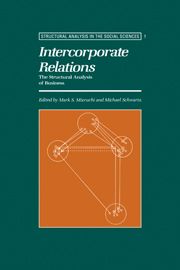Book contents
- Frontmatter
- Contents
- List of figures
- List of tables
- Introduction
- I Theoretical perspectives
- II National and international business structures: a comparative perspective
- 6 The structure of class cohesion: the corporate network and its dual
- 7 Intercorporate structures in Western Europe: a comparative historical analysis
- 8 The articulation of power and business structures: a study of Colombia
- 9 Business–government relations in modern Japan: a Tōdai–Yakkai–Zaikai complex?
- 10 International bank capital and the new liberalism
- Index of authors
- Subject index
6 - The structure of class cohesion: the corporate network and its dual
Published online by Cambridge University Press: 04 February 2010
- Frontmatter
- Contents
- List of figures
- List of tables
- Introduction
- I Theoretical perspectives
- II National and international business structures: a comparative perspective
- 6 The structure of class cohesion: the corporate network and its dual
- 7 Intercorporate structures in Western Europe: a comparative historical analysis
- 8 The articulation of power and business structures: a study of Colombia
- 9 Business–government relations in modern Japan: a Tōdai–Yakkai–Zaikai complex?
- 10 International bank capital and the new liberalism
- Index of authors
- Subject index
Summary
Introduction
The techniques of structural analysis have been applied to the business community in various ways and a particularly popular application has been in the study of interlocking directorates. Assuming that intercorporate relations can be traced through an investigation of structural ties, recent work in the area has mapped corporate interaction patterns in an attempt to address the question of cohesion within the business community. A consistent finding of such network analyses has been the identification of commercial banks as important actors in the world of big business (Bearden et al., 1975; Mariolis, 1975; Sonquist and Koenig, 1975; Norich, 1980; Mintz and Schwarz, 1981; Mizruchi, 1982, 1983; see also Allen, 1974; Burt, 1979, 1980, 1983). Many investigators have concluded from this and similar evidence that bank boards are the primary location for collective decision-making within the corporate world (Bearden, 1982; Glasberg, 1981; Mintz and Schwartz, 1985).
At the same time, a second set of studies has focussed on identifying sources of cohesion within the capitalist class, concentrating on the role of individuals in unity formation. Research in this realm has identified shared background, friendship networks, and membership on policy planning bodies as mechanisms of cohesion. Domhoff's (1967, 1970, 1975, 1979, 1983) work has been particularly good in identifying institutions dominated by the capitalist class and documenting their usefulness in cohesion formation. Useem (1978, 1979, 1984) has investigated class fractions, arguing that members of the inner group of the capitalist class – including, among others, business people with ties to multiple companies – are in a position to transcend individual interests and formulate general class policy.
- Type
- Chapter
- Information
- Intercorporate RelationsThe Structural Analysis of Business, pp. 187 - 207Publisher: Cambridge University PressPrint publication year: 1988
- 8
- Cited by



